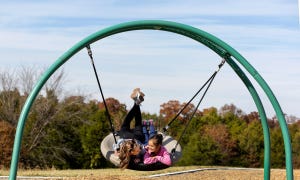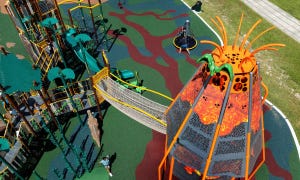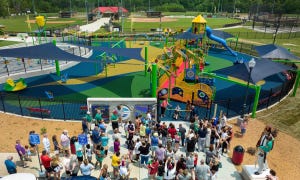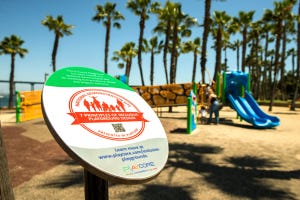While inclusive playgrounds are intended to break down and eliminate barriers to play, some barriers are essential to making a playground a secure space for children with special needs, particularly children with intellectual disability. The CDC reports that 12 in 1,000 children in the United States have some form of cognitive impairment and that one in 88 children are on the autism spectrum. (1)
According to a 2012 study in Pediatrics, 49% of parents of children with cognitive impairments reported their child had run away or attempted to run away after the age of 4. Of those, 26% were missing long enough to cause concern. (2)
This behavior of wandering off or running away is called "elopement" by clinicians and it is a common occurrence in children with Autism Spectrum Disorder. Elopement is not limited to children with Autism, however. Most children with cognitive and/or sensory processing impairment (Down syndrome, Autism Spectrum Disorder, Traumatic Brain Injury and other non-specific developmental delays) are prone to wander off or run away. These behaviors are sometimes preceded by specific triggers, but often are unpredictable.
Elopement is covered as part of the intake process at schools, churches, and other organizations that serve children and families. While the best line of defense for preventing elopement is close parental supervision, even the most attentive parents have experienced an episode that caused concern, and/or resulted in tragic results.
Public playgrounds can help reduce elopement episodes by enclosing the play space with appropriate barriers or fencing to prevent children from leaving the area. Communities who build playgrounds near hazards such as bodies of water or steep terrain should consider fencing or barriers because children with cognitive impairments have a reduced sense of fear and may enter dangerous situations without an understanding of the consequences.
There are many fencing options available for playgrounds, depending on the site conditions, jurisdictional requirements and aesthetic preference. In the United States the CPSC Public Playground Safety Handbook states that if a playground is near accessible hazards, the fencing method should conform to local building codes and/or ASTM F-209.(3) Fences or barriers can even be constructed, in part or whole, from similar materials as the playground itself. By adding activity panels, musical instruments and other accessible attachments to the fencing, you increase the overall play value of the playground and make the fence or barrier part of the inclusive play space. GameTime representatives can help you design a fencing option that matches the look of your playground and enhances the play experience for children of all abilities.
By considering the needs of the whole child, and preparing the play space for the unique needs of all children, your community can help create a recreation area that children can enjoy and one in which parents of children with special needs can feel comfortable.
Kent Callison
1. Division of Birth Defects, National Center on Birth Defects and Developmental Disabilities, Centers for Disease Control and Prevention, June 27, 2013, http://www.cdc.gov/ncbddd/autism/data.html
2. PEDIATRICS Vol. 130 No. 5 November 1, 2012, pp. 870 -877, doi: 10.1542/peds.2012-0762
3. CPSC Handbook for Public Playground Safety, U.S. Consumer Product Safety Commission, Sec. 2.1, p.5
- Trails (27)
- Schools (192)
- Press Releases (109)
- Playground Funding (5)
- Play Science & Research (62)
- Parks & Recreation (360)
- Outdoor Fitness (138)
- National Demonstration Site (32)
- Landscape Architects (78)
- Inclusive Play (109)
- Daycare and Early Learning (62)
- Custom Play (38)
- College Campus (28)
- Churches (51)
- Challenge Course (30)
- Featured Projects (77)
- BluePrint for Play (18)
- Site and Shade (9)





